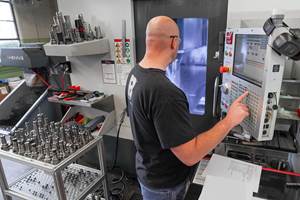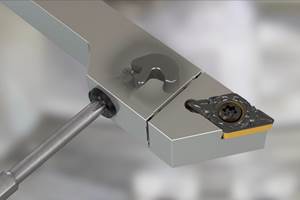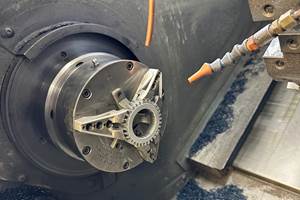Rigid Tapping--Sometimes You Need A Little Float
One of the most common methods of tapping in use today on CNC machines is 'rigid tapping' or 'synchronous feed tapping.' A rigid tapping cycle synchronizes the machine spindle rotation and feed to match a specific thread pitch. Since the feed into the hole is synchronized, in theory a solid holder without any tension-compression can be used.
Share





One of the most common methods of tapping in use today on CNC machines is “rigid tapping” or “synchronous feed tapping.” A rigid tapping cycle synchronizes the machine spindle rotation and feed to match a specific thread pitch. Since the feed into the hole is synchronized, in theory a solid holder without any tension-compression can be used.
However the problem with this is that in actual practice it is impossible for the machine to exactly match the pitch of the specific tap being used. There is always a slight discrepancy between what the machine is doing and the actual pitch of the tap. If a solid holder is used, this discrepancy is detrimental to tap life and thread quality because extra axial forces are exacted on the tap.
If a tap holder with tension-compression float is used, tap life and thread quality can be dramatically improved, because these extra axial forces on the tap are eliminated. The problem with traditional tension-compression holders is that they can cause large variations in tapping depth. As a tap becomes dull, the pressure needed to start the tap into the hole increases, and more compression stroke within the tap driver is used before the tap starts to cut. The result is a shallower tapping depth.
One of the main advantages of rigid tapping is depth control accuracy on blind holes. To do the job accurately and consistently, a holder is needed that has enough compensation to get good tap life without causing variations in depth control.
Tapmatic (Post Falls, Idaho) has developed a new tap holder design that uses a machined flexure in the holder shank to provide the small amount of compensation needed for rigid tapping. The company calls this new holder SynchroFlex.
Unlike the coil springs used commonly in traditional tension-compression holders, the SynchroFlex flexure has a very precise, and a very strong, spring rate. For example, a typical tap holder’s tension-compression coil spring has a spring rate of 29 pounds/inch. Compare this to the SynchroFlex flexure rate of about 1,500 pounds/inch. A high spring rate is exactly what is needed for the small amounts of axial compensation required to improve rigid tapping. It is this small, controlled compensation that enables these holders to improve thread quality and in some rigid tapping applications, double tap life.
Even though the discrepancy between the machine synchronization and the tap pitch is very small, the forces exerted on the tap with a solid holder are high. Measuring the thrust forces shows that a solid holder can exert 84 times greater axial forces on the tap than when using a SynchroFlex tap holder doing exactly the same rigid tapping operation.
The flexure is designed for long term duty. The movement of the flexure is limited to a safe operating range so it is not overstressed. Torque is not transmitted through the flexure. It is only used for the axial compensation. As testimony, a SynchroFlex holder that had tapped more than 1.5 million holes was recently checked and found to still have the same force to deflection ratio as it had when new.
These new tap holders are more expensive than standard collet holders, but if your shop is having trouble holding depth on rigid tapped holes or getting optimum tap life, it may be worth trying the new tap holder design. It may be less expensive in the long term.
Related Content
Medical Shop Performs Lights-Out Production in Five-Axes
Moving to five-axis machining enabled this shop to dramatically reduce setup time and increase lights-out capacity, but success relied on the right combination of workholding and automation.
Read MoreBriquetting Manufacturer Tools Up for Faster Turnaround Times
To cut out laborious manual processes like hand-grinding, this briquette manufacturer revamped its machining and cutting tool arsenal for faster production.
Read MoreQuick-Change Tool Heads Reduce Setup on Swiss-Type Turning Centers
This new quick-change tooling system enables shops to get more production from their Swiss turning centers through reduced tool setup time and matches the performance of a solid tool.
Read MoreChuck Jaws Achieve 77% Weight Reduction Through 3D Printing
Alpha Precision Group (APG) has developed an innovative workholding design for faster spindle speeds through sinter-based additive manufacturing.
Read MoreRead Next
Machine Shop MBA
Making Chips and Modern Machine Shop are teaming up for a new podcast series called Machine Shop MBA—designed to help manufacturers measure their success against the industry’s best. Through the lens of the Top Shops benchmarking program, the series explores the KPIs that set high-performing shops apart, from machine utilization and first-pass yield to employee engagement and revenue per employee.
Read MoreAMRs Are Moving Into Manufacturing: 4 Considerations for Implementation
AMRs can provide a flexible, easy-to-use automation platform so long as manufacturers choose a suitable task and prepare their facilities.
Read More





















